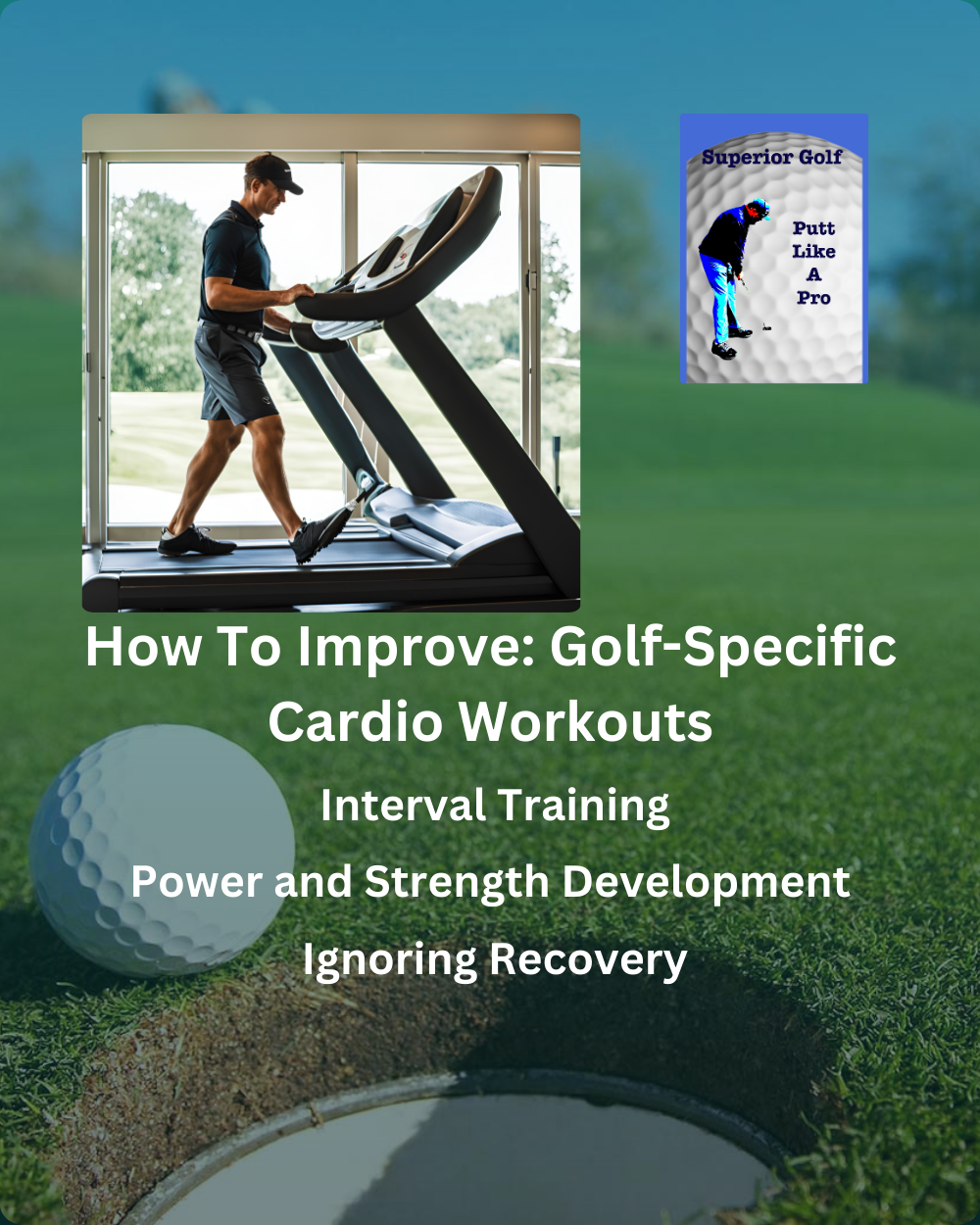Golf-Specific Cardio Workouts: Picture this, you’re at the first tee with clubs in hand, heart racing with excitement. You’re about to play a long game. Each hole challenges you to bring your best. Have you ever longed for that bit of extra energy to stay strong from start to finish? The key to maximizing your game lies in adding the right cardio to your routine. Golf fitness isn’t just about being strong and flexible. It’s also about keeping up the stamina you need for both power and accuracy, from the first swing to the last putt.
Golf requires specific physical efforts, so your cardio workouts should reflect that. Despite what some think, golf involves quick, intense spurts of activity, not just leisurely walks. A good cardio routine can improve your club head speed, which is crucial for hitting the ball farther and playing better. To give you an idea, PGA Tour players swing 20mph faster than LPGA Tour players and 10mph faster than Champions Tour players1. This speed difference means a lot more distance, showing just how vital cardio is for your practice.
So, what’s the best way to boost your cardio? Choose golf-specific exercises that focus on increasing both your staying power and your swing speed. These workouts should have lively movements and intervals. They replicate the intense efforts you put into each round of golf. Working on your cardio helps you not just in walking over four miles on the course2. It also helps in getting that forceful drive needed for each shot.
Key Takeaways
- Cardiovascular fitness is crucial for maintaining consistent energy and power throughout a round.
- The average PGA Tour club head speed is significantly higher than that of the LPGA and Champions Tours1.
- Golf-specific cardio should prioritize explosive power and interval training over steady-state cardio.
- Proper cardio training can enhance endurance and improve overall golf performance, including driving distance.
- Walking 18 holes of checks our strength over more than four miles2.
Understanding the Role of Cardio in Golf Fitness
Cardio fitness is key in golf for keeping up energy and focus. Golf cardio doesn’t need to be high-intensity. It should help with endurance to maintain good play.
Importance of Cardiovascular Fitness for Golfers
Golfers need strong cardio to avoid getting tired during games and to recover quickly. They walk three to five miles on average during an 18-hole game. This can burn a lot of calories3. Better cardio means more oxygen for muscles, which boosts power in swings and overall performance4.
Cardio Demands of Golf
Golfers need cardio that mimics walking and the gentle hills of a golf course. Fitness pros suggest hiking, jogging, and walking outdoors to build endurance. This prepares muscles well for the game3. Pros might choose harder cardio workouts to match their game’s intensity3.
It’s also smart for golfers to do power training. Short, intense exercises help with the powerful swings needed in golf4. This kind of training fits the sport’s needs without too much cardio stress.
Effective Golf-specific Cardio Workouts
Adding interval training to your golf workouts boosts your stamina and helps you recover quickly between shots. This training involves short periods of intense exercise followed by rest. It mirrors what your body goes through in a golf game.
Interval Training
Interval training is key for golfers to perform better. It switches between hard exercise and rest, just like golf does. Golfers focus on explosive training instead of just running. This keeps their leg strength up5. These workouts help golfers recover faster and increase their power and endurance.
Golfers’ heart rates often reach 140-160 during strength training5. This is similar to interval training. It prepares them for the energy bursts needed for powerful drives and swings. This helps keep their game strong.
Power and Strength Development
Building power and strength is crucial for better golf performance. Activities like sprints and plyometric jumps turn on fast-twitch muscles, boosting your power6. Sprints, especially during the season, make your legs stronger. Stronger legs help you swing faster5.
Top golfers, like Lucas Glover and Jessica Korda, focus on legs and hips. They do exercises that make them stronger and more flexible. Doing these regularly enhances your swing speed and keeps you energized7.
For top-notch golf fitness, mix interval training with exercises that build power. This approach enhances your game and lowers injury risks. It keeps you playing your best golf.
Common Mistakes and How to Avoid Them
Many golfers think running a lot will make them better at golf. This isn’t always true, as it might hurt your swing power. Long runs work your slow-twitch muscles, not the quick ones you need for a good swing. Instead, try short, high-energy workouts that match golf’s needs better.
Overemphasis on Distance Running
High-intensity training fits golf better than long, slow runs. Running too much can reduce your swing power. Adding workouts that focus on speed and strength, like swinging and jumping, helps a lot4. These activities increase your heart’s fitness and recovery, which is great for golfing, especially in tournaments or on trips4.
Ignoring Recovery
Recovery is key in a golf workout routine. Feeling tired while playing is often due to bad nutrition, not enough water, or mental stress4. It’s critical to rest, eat right, and stay hydrated for the best performance. A low resting heart rate, under 60 beats per minute, is also important8. Paying attention to these factors helps avoid mistakes and keeps you strong and ready, especially in important moments.
Conclusion
To sum up, making your cardio workouts golf-specific is key to getting better at golf. These workouts help meet the sport’s needs, not just keeping you fit. Focusing on short, intense exercise snapshots fits the sport’s nature, boosting your power and stamina6.
Adding power and strength workouts is also important. They work on big muscle groups like your core, legs, and shoulders. This makes your golf swing stronger and lets you hit the ball farther, which helps improve your game6. Working on your balance and stability is important too. It makes your swing more powerful and effective by strengthening your glutes and lower back6.
It’s a bad idea to only focus on long-distance running since it could reduce your swing power. Also, remember recovery is just as important as exercising. Cardio and endurance help you stay strong and focused for your entire game, keeping your energy up6. By crafting a workout plan that meets these needs, you’ll see big gains in your performance.
If you want more tips on golf fitness, check out this detailed guide. It gives you more ways to make your training better here. With these approaches, you’ll get stronger and smarter on the golf course.
FAQ
Why is cardiovascular fitness important for golfers?
What type of cardio workouts are recommended for improving golf performance?
What are some effective exercises to increase power and strength for golf?
How important is recovery in a golf fitness regimen?
How can interval training improve a golfer’s game?
Source Links
- https://fitforgolf.blog/2021/08/13/in-season-workouts-how-to-balance-with-golf/
- https://www.performancegolf.com/blog/the-best-golf-exercises-to-improve-your-golf-swing
- https://collegeofgolf.keiseruniversity.edu/importance-golf-cardio/
- https://fitforgolf.blog/2020/08/25/the-truth-about-cardio-for-golf/
- https://www.golfwrx.com/632540/golfers-and-distance-running/
- https://www.golfmekka.com/uncategorized/the-benefits-of-using-golf-specific-fitness-training-and-exercises-to-improve-your-game/
- https://golf.com/instruction/fitness/6-exercises-golf-game-in-shape/
- https://www.strongergolf.co.uk/single-post/2017/10/16/why-your-cardio-workout-sucks

